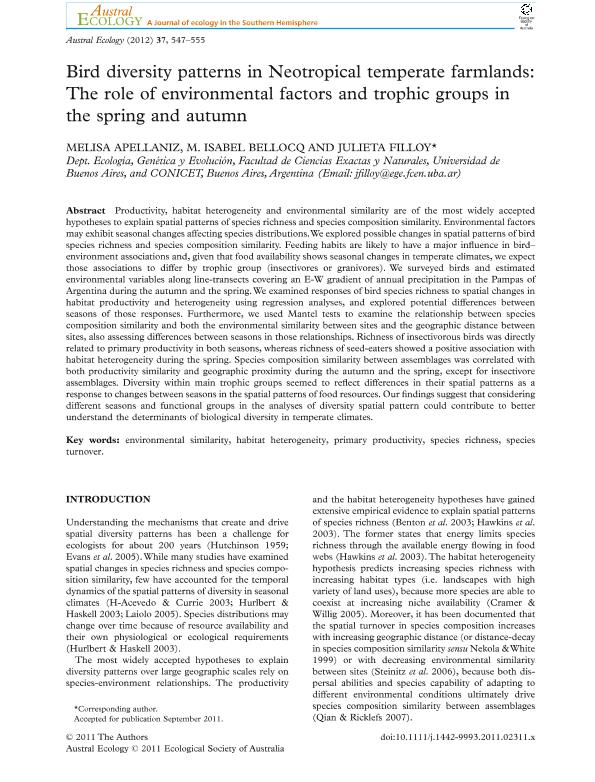Artículo
Bird diversity patterns in Neotropical temperate farmlands: The role of environmental factors and trophic groups in the spring and autumn
Fecha de publicación:
08/2012
Editorial:
Wiley Blackwell Publishing, Inc
Revista:
Austral Ecology
ISSN:
1442-9985
Idioma:
Inglés
Tipo de recurso:
Artículo publicado
Clasificación temática:
Resumen
Productivity, habitat heterogeneity and environmental similarity are of the most widely accepted hypotheses to explain spatial patterns of species richness and species composition similarity. Environmental factors may exhibit seasonal changes affecting species distributions. We explored possible changes in spatial patterns of bird species richness and species composition similarity. Feeding habits are likely to have a major influence in bird-environment associations and, given that food availability shows seasonal changes in temperate climates, we expect those associations to differ by trophic group (insectivores or granivores). We surveyed birds and estimated environmental variables along line-transects covering an E-W gradient of annual precipitation in the Pampas of Argentina during the autumn and the spring. We examined responses of bird species richness to spatial changes in habitat productivity and heterogeneity using regression analyses, and explored potential differences between seasons of those responses. Furthermore, we used Mantel tests to examine the relationship between species composition similarity and both the environmental similarity between sites and the geographic distance between sites, also assessing differences between seasons in those relationships. Richness of insectivorous birds was directly related to primary productivity in both seasons, whereas richness of seed-eaters showed a positive association with habitat heterogeneity during the spring. Species composition similarity between assemblages was correlated with both productivity similarity and geographic proximity during the autumn and the spring, except for insectivore assemblages. Diversity within main trophic groups seemed to reflect differences in their spatial patterns as a response to changes between seasons in the spatial patterns of food resources. Our findings suggest that considering different seasons and functional groups in the analyses of diversity spatial pattern could contribute to better understand the determinants of biological diversity in temperate climates.
Archivos asociados
Licencia
Identificadores
Colecciones
Articulos(IEGEBA)
Articulos de INSTITUTO DE ECOLOGIA, GENETICA Y EVOLUCION DE BS. AS
Articulos de INSTITUTO DE ECOLOGIA, GENETICA Y EVOLUCION DE BS. AS
Citación
Apellaniz, Melisa Florencia; Bellocq, Maria Isabel; Filloy, Julieta; Bird diversity patterns in Neotropical temperate farmlands: The role of environmental factors and trophic groups in the spring and autumn; Wiley Blackwell Publishing, Inc; Austral Ecology; 37; 5; 8-2012; 547-555
Compartir
Altmétricas




